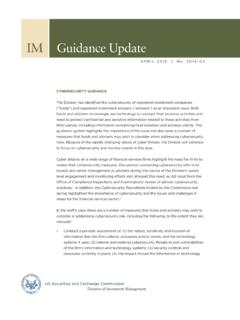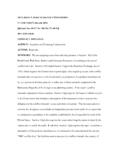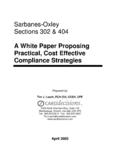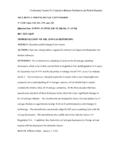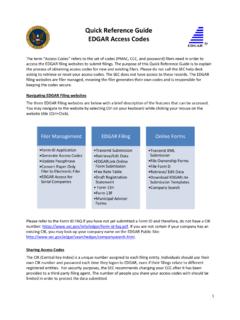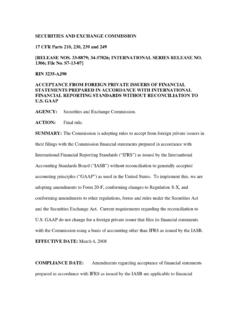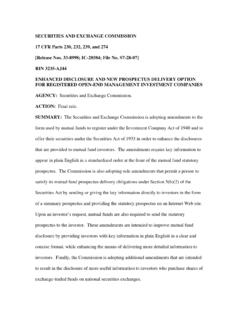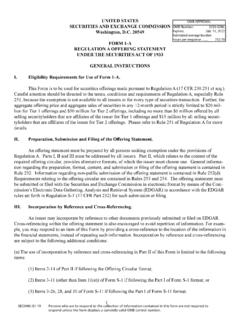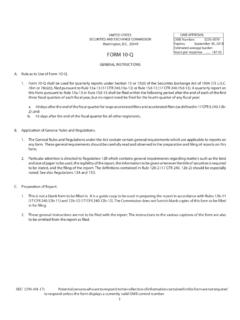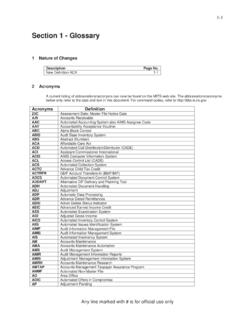Transcription of Third-Party Risk Management Framework - SEC
1 File No. SR-OCC-2020-014 Page 140 of 221 Third-Party Risk Management Framework PUBLIC Exhibit 5a Owner: Chief Risk Officer Effective Date: Document Type: Regulatory Board Approval: Risk Committee Rule Filed: Yes I. EXECUTIVE SUMMARY As a central counterparty, the Options Clearing Corporation ( OCC ) is exposed to risks arising from its Third-Party relationships. This Third-Party Risk Management Framework ( Framework ) outlines OCC s approach to identify, measure, monitor, and manage risks arising from Third-Party relationships including: Clearing Members Clearing Banks, custodians, liquidity providers, and investment counterparties ( Financial Institutions ) Financial market utilities ( FMU )1 Exchanges2 Vendors This Framework is approved by the Risk Committee of OCC s Board of Directors ( Risk Committee ) at least annually and implemented by the Management Committee ( MC ).
2 II. RISK IDENTIFICATION OCC faces risks associated with its Third-Party relationships, including: Financial risks arising from a Clearing Member failing to meet its financial obligations to OCC including, but not limited to, obligations related to settlement, margin, and Clearing Fund. OCC may also face financial risks from other third -Parties not meeting their obligations to OCC, including, but not limited to, facilitating daily settlements, providing timely access to collateral, honoring liquidity draw requests, or meeting obligations under an agreement. Operational risks arising from errors, disruptions, failures, or the inability of a Third-Party to fulfill its obligations to OCC. These risks include a disruption preventing OCC from completing trade processing, daily settlements, accessing collateral, or safeguarding OCC property, equipment, or personnel.
3 Information Technology and Security risks arising when a Third-Party is unable to safeguard OCC data or maintain capabilities or services to support OCC s operations. 1 FMUs may include any person that manages or operates a multilateral system for the purpose of transferring, clearing, or settling payments, securities, or other financial transactions among Financial Institutions or between Financial Institutions and the person. 2 Exchange relationships may include options exchanges, futures markets, OTC Trade Sources, or Loan Markets. File No. SR-OCC-2020-014 Page 141 of 221 Third-Party Risk Management Framework PUBLIC Exhibit 5a Legal and Regulatory risks arising when a Third-Party fails to fulfill its obligations to OCC.
4 These risks include exposure to potential litigation or regulatory compliance concerns. III. RELATIONSHIP LIFECYCLE OCC s relationship lifecycle is designed to identify, measure, monitor, and manage Third-Party risks . The lifecycle consists of three stages. On-Boarding third -Parties are evaluated to determine whether they can engage in or expand a relationship with OCC. After evaluation, OCC completes any operational tasks necessary to activate the relationship. Ongoing Monitoring third -Parties are monitored for compliance with standards, the presence of additional or increased risks , and fulfillment of contractual obligations. Ongoing monitoring is conducted based upon the nature of each relationship and is commensurate with the risks posed by the Third-Party .
5 Off-Boarding third -Parties or OCC may elect to terminate a relationship. Following the determination to terminate a relationship, OCC completes any operational tasks necessary to off-board the relationship. third -Parties that have multiple relationships with OCC are subject to the processes described below for each type of relationship. OCC recognizes that multiple relationships with a single entity may result in additional risks (as identified in Section II) and incorporates this into its on-boarding and ongoing monitoring by reviewing affiliated relationships and their exposures at the Credit and Liquidity Risk Working Group. As described below, risks identified throughout the relationship lifecycle are reported and escalated through associated working groups.
6 Working groups are cross-departmental and support OCC s business as assigned by the MC. Each working group has a chair and designated MC member who are responsible to determine the matters to be escalated to the MC. The working groups identified in this Framework have defined decision-making authority, functions and responsibilities as defined in the associated working group procedure. The working groups that support the activities described in this Framework are: Credit and Liquidity Risk Working Group ( CLRWG ) Exchange Working Group ( EWG ) Vendor Risk Working Group ( VRWG ) IV. Third-Party RELATIONSHIP Management Clearing Members OCC s membership standards are designed to be objective and risk-based, and are publicly disclosed in OCC s Rules and By-Laws.
7 Annually, Business Operations, Financial Risk Management ( FRM ), Treasury, and Third-Party Risk Management ( TPRM ) assess the adequacy of OCC s membership standards to address the Management of risks presented by Clearing Members and the processes used to monitor initial and ongoing compliance with those standards, in accordance with the Credit and File No. SR-OCC-2020-014 Page 142 of 221 Third-Party Risk Management Framework PUBLIC Exhibit 5a Liquidity Risk Working Group Procedure. The review may contain recommendations to change the standards or monitoring processes. The results of the annual assessment are summarized for consecutive review and approval by the CLRWG, MC, Risk Committee, and if rule changes are necessary, the Board of Directors. On-Boarding: Business Operations, FRM, and TPRM complete a risk-based evaluation of Clearing Member applicants by evaluating their financial resources, operational capacity, personnel, and facilities against OCC s membership standards.
8 FRM presents the results of this evaluation to the CLRWG and other key stakeholders as identified within Article V, Section 2 of OCC s By-Laws for review and approval. Ongoing Monitoring: Clearing Members are monitored for ongoing compliance with OCC s membership standards. FRM, with support from Business Operations and TPRM, performs Watch Level reporting and ongoing monitoring of financial and operational risks . In addition to or in support of Watch Level reporting, Business Operations and FRM conduct the following processes to monitor Clearing Members: Determining an internal credit rating to identify creditworthiness; Performing periodic examinations to evaluate Clearing Member risk Management policies, procedures, and practices; and Evaluating material risks related to customers of Clearing Members.
9 FRM provides informational Watch Level reporting at meetings of the CLRWG, MC, and Risk Committee that summarizes the circumstances leading to violations of higher tier Watch Level criteria, additional risks observed, and any corrective measures taken by such Clearing Members. Should a Clearing Member approach or no longer meet minimum membership standards, protective measures may be imposed to limit or eliminate OCC s counterparty exposure. OCC maintains authorities in its Rules (Chapter III, Chapter VI Rule 608, and Chapter VII Rules 704 and 707) to act to protect OCC, given the facts and circumstances of the exposure presented by a Clearing Member, including but not limited to the imposition of additional monitoring, changes to margin requirements or composition, or suspension of some or all product and account approvals.
10 Business Operations, FRM, and TPRM provide reporting to the CLRWG, comprised of results from ongoing monitoring and Management of Clearing Member financial, operational, legal, and regulatory risks and may raise matters for consideration to the CLRWG. The CLRWG may take action or escalate the matter to the MC, in accordance with the functions and responsibilities assigned to the CLRWG by the MC in the Credit and Liquidity Risk Working Group Procedure. Off-Boarding: A Clearing Member may voluntarily terminate its membership. Upon request for termination, Business Operations and FRM ensure all financial exposures and operational capabilities are wound down and all obligations to OCC are satisfied before the relationship is terminated. In the event a Clearing Member is suspended by OCC, the suspension will be managed in accordance with the Default Management Policy.
